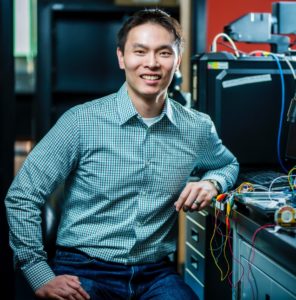We are delighted to introduce our latest Lab on a Chip Emerging Investigator – Steve Shih!
Steve Shih completed his BASc in Electrical Engineering from Toronto and then went to University of Ottawa to complete his Master’s degree in Chemistry. He then returned to Toronto to complete his Ph.D in Biomedical Engineering in Aaron Wheeler’s laboratory. He then spent two years at UC Berkeley and at the Joint BioEnergy Institute (JBEI) as a postdoctoral researcher and worked closely with collaborators Jay Keasling and Nathan Hillson. He learned pathway engineering of microbes for biofuel production using synthetic biology tools and published four papers related to this research. As of January 2016, he became an Assistant Professor at Concordia University in the Department of Electrical and Computer Engineering with appointments in the Department of Biology and the Center for Applied Synthetic Biology. His current research entails combining new microfluidic platforms with synthetic biological tools to solve challenges in the health, energy, and medical fields.
Read his Emerging Investigators paper “Image-based Feedback and Analysis System for Digital Microfluidics” and find out more about his research in the interview below:
Your recent Emerging Investigator Series paper focuses on an image-based feedback system for digital microfluidics How has your research evolved from your first article to this most recent article?
Wow it has evolved immensely! I started off as a naïve graduate student dabbling in the field of NMR and using that technique to determine structures of membrane proteins. My first paper described how we used computational and experimental techniques to optimize the determination of membrane protein structures. I learned so much in the field of chemistry and molecular biology, especially coming from an engineering background.
Now my research is in microfluidics and I am using this technique to solve some challenging biological problems. Although the topics are completely different – the techniques that I learned previously has helped to find interesting solutions to engineering problems. I am always excited to dabble in new and exciting fields and integrating traditional fields with the new.
What aspect of your work are you most excited about at the moment?
I just recently started my lab and there are so many exciting new projects. My lab is currently working on integrating microfluidics and automating processes related to synthetic biology. Synthetic biology has evolved towards engineering new organisms to produce vast quantities of valuable products, such as biorenewable fuels. This promise (and among many others) has been inspired by biologists that believe genetic engineering of biological cells can be more like the engineering of any hardware. However, challenges loom at multiple steps in the process and our lab is using microfluidics that will overcome these (or least some) challenges.
In your opinion, what is the biggest advantage of this technology and how will this impact digital microfluidics?
I am very excited about this paper because it is the first time that imaging techniques for feedback has been applied to digital microfluidics. One of the biggest challenges with digital microfluidics is the reliability of droplet movement – i.e. an application of a potential does not always equate to a droplet movement. This problem is exacerbated when we are multiplexing droplet movement – more droplets will fail during operation. We have developed a method in which we can individually detect all the droplets on the device using image-based techniques. This is a huge advantage since we only require applying a feedback mechanism to only those droplets that failed in movement while it does not delay the movement of other droplets that translated successfully on the device. This optimizes the time a droplet rests on an electrode and can minimize other effects that prevent droplet movement (e.g., biofouling).
What do you find most challenging about your research?
Everything, but this is why I love my inter-disciplinary research field since it involves so many different aspects. Some examples are trying to understand the underlying mechanisms of breast cancer to resolving issues of integrating synthetic biology techniques at the microscale.
In which upcoming conferences or events may our readers meet you?
I will be attending MicroTAS this year in Savannah and two of my students will be presenting posters. I will also be attending the 4BIO gene editing and synthetic biology conference at London, UK in December, where I will be giving a talk to describe some our microfluidic work with synthetic biology.
How do you spend your spare time?
Spare time is so rare among new professors. But I spend most of my time chasing my kids and trying to excite them for what is to come…
Which profession would you choose if you were not a scientist?
This is a tough question. I really love my job as an educator and everything else that comes with it. But if I had to choose something else, I think I would be a sports broadcaster on ESPN. I love sports and I am an avid fan of tennis and basketball. It would be my dream to commentate a Roger Federer game or to call a Toronto Raptors game.
Can you share one piece of career-related advice or wisdom with other early career scientists?
Failure is inevitable. I failed so many times during my career and it is all part of the learning process. Young scientists should embrace failure and learn as much as they can from it – don’t be afraid of it! They do not realize that failure is where new innovation and ideas come from. I definitely would not be where I am today if it was not for failure.











